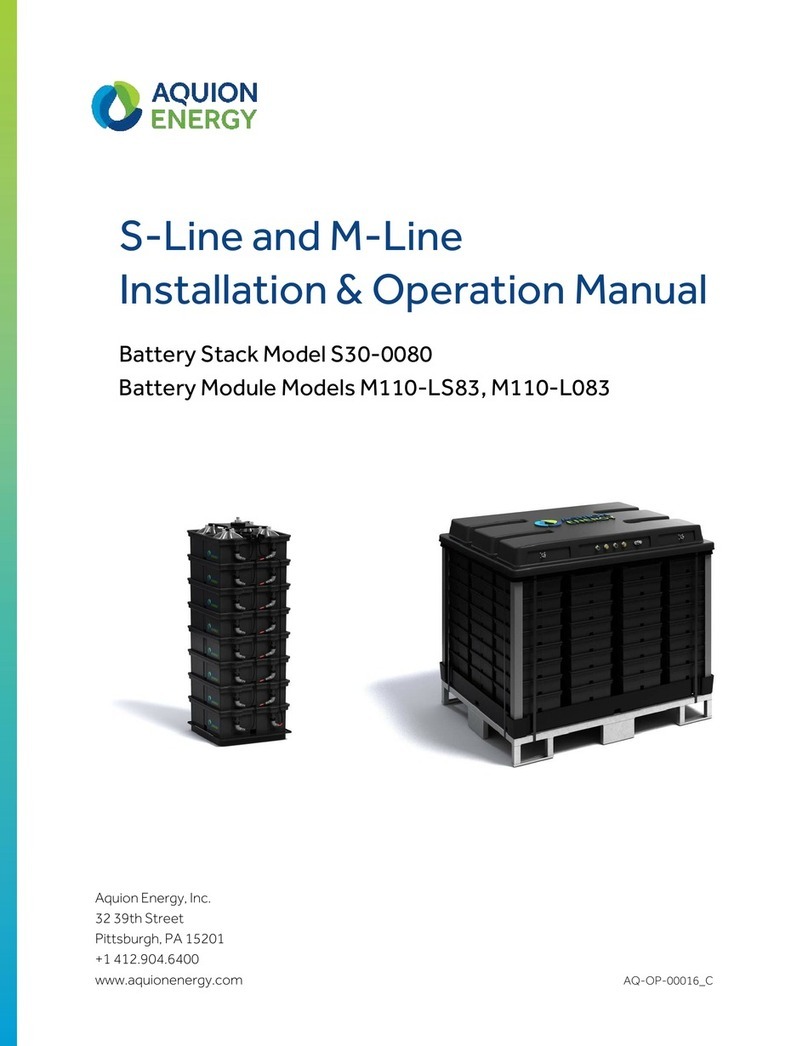Aquion Energy S20-008F User manual

AQ‐OP‐00009_B
OperationsManual
BatteryStackModelsS20‐008F,S20‐0080
AquionEnergy,Inc.
www.aquionenergy.com

1AQ‐OP‐00009_B
TableofContents
1.GeneralInformation.................................................................................................................................3
1.1AboutThisManual.............................................................................................................................3
1.2ContactInformation...........................................................................................................................3
2.ProductInformation..................................................................................................................................3
2.1AHI™BatteryTechnology...................................................................................................................3
2.2S20‐0080BatteryStackOverview......................................................................................................3
2.3PhysicalCharacteristics......................................................................................................................3
2.4TerminalOverview.............................................................................................................................3
3.SafetyInformation....................................................................................................................................4
3.1GeneralSafetyInformation................................................................................................................4
3.2ElectricalHazards...............................................................................................................................4
3.3ElectricalSafety..................................................................................................................................4
3.4ChemicalHazards...............................................................................................................................5
3.4.1GasEmissions..............................................................................................................................6
3.5MechanicalHazards...........................................................................................................................6
3.6TransportationHazards......................................................................................................................6
3.7WeightHazards..................................................................................................................................6
3.8EnvironmentalConsiderations...........................................................................................................6
3.9RecyclingandDisposal.......................................................................................................................7
4.ReceiptofEquipment...............................................................................................................................7
4.1DeliveryInspection.............................................................................................................................7
4.2HiddenDamage..................................................................................................................................7
4.3Actions................................................................................................................................................7
5.InstallationProcedures.............................................................................................................................7
5.1Unpacking...........................................................................................................................................7
5.2Installation..........................................................................................................................................7
5.3ElectricalInterfacesandConnections................................................................................................8
5.4WiringDiagrams.................................................................................................................................8
5.5VentilationGuidelines........................................................................................................................9
6.Operation..................................................................................................................................................9
6.1ConfigurationandOperationRequirements.....................................................................................9
6.2InitialCharge....................................................................................................................................10
6.3Discharge/ChargeCycles..................................................................................................................10
6.4StateofCharge.................................................................................................................................13

2AQ‐OP‐00009_B
6.5RecordKeeping................................................................................................................................13
6.6OperationalRecords........................................................................................................................14
6.7Long‐TermStorage...........................................................................................................................14
6.8DischargeLoadVoltagefrom100%SOC..........................................................................................15
6.9EnergyEfficiency..............................................................................................................................16
7.Warranty.................................................................................................................................................18
8.TechnicalSupportandTroubleshooting.................................................................................................18
9.Disclaimers..............................................................................................................................................18
AppendixA:FrequentlyAskedQuestions...................................................................................................19
AppendixB:OperationalSettingsforOff‐GridPowerControlElectronics.................................................21
B.1OperationalSettingsforOff‐GridPowerControlElectronics..........................................................21
B.1.1Definitions.................................................................................................................................21
B.1.2VoltageLimitsvs.Temperature................................................................................................21
B.1.3HowtoChargeAquionBatteries..............................................................................................21
B.1.4TemperatureCompensation.....................................................................................................22
B.2Off‐GridDevice‐SpecificSettingsbyManufacturer.........................................................................22
B.2.1Morningstar..............................................................................................................................22
B.2.2MidniteClassic..........................................................................................................................24
B.2.3Outback.....................................................................................................................................24
B.2.4SMASunnyIsland......................................................................................................................25
B.2.5SchneiderConextXW+.............................................................................................................26
B.3Grid‐Tied/UPSDevice‐SpecificSettingsbyManufacturer...............................................................26
B.3.1MidniteClassic.........................................................................................................................26
B.3.2Outback....................................................................................................................................26
B.3.3SMASunnyIsland.....................................................................................................................28
B.3.4SchneiderConextXW+.............................................................................................................28
B.3.5AbsorptionVoltagevs.ChargeCurrent,30°C...........................................................................29
B.4ReferenceCyclesforLabUse..........................................................................................................29

3AQ‐OP‐00009_B
1.GeneralInformation
1.1AboutThisManual
Thismanualisintendedtoprovidetechnicalinformationandsafepracticesregardingreceiving,
installing,operating,andservicingtheAquionEnergyS20‐0080andS20‐008FBatteryStacks.For
completesafetyinformation,refertotheSafetyDataSheet(SDS)includedwithyourproductshipment.
NOTICE:Failuretofollowtheinstructionsinthisdocumentcouldresultinfire,electricshock,
and/orotherinjuryordamage.
1.2ContactInformation
AquionEnergy,Inc.
3239thStreet
Pittsburgh,PA15201
412.904.6400
www.aquionenergy.com
2.ProductInformation
2.1AHI™BatteryTechnology
AquionEnergy’sAqueousHybridIon(AHI™)batteriesareoptimizedforstationaryapplicationswith
charge/dischargeratesgreaterthan4hours.Thebatteriesaredesignedtohaveextremelylongcyclelife
atfulldepthofdischargewithminimaldegradation,theabilitytostandatpartialstateofchargewith
minimalself‐dischargeorlossinfunction,andextensivefaulttolerance.
2.2S20‐0080BatteryStackOverview
TheS20‐0080andS20‐008FBatteryStack(hereafter“BatteryStack”)isthebasecomponentofAquion
Energy’sscalableenergysolutions.TheBatteryStackiscomposedofeightB20batteriesconnectedin
series,builttobevoltage‐optimizedforsafetyandsystemarchitecture.TheS20‐008Fincludesanin‐line
15‐ampere(A)fuse.BatteryStackscanbescaledinseriesorparallelforawiderangeofstationary
systemrequirements.Fordetailedspecifications,pleaseseethelatestProductSpecificationSheet,
availableontheAquionEnergyCustomerPortalathttp://info.aquionenergy.com/customer‐portal.
2.3PhysicalCharacteristics
Forproductphysicalcharacteristicsandmeasurements,pleaseseethelatestProductSpecification
Sheet(visithttp://info.aquionenergy.com/customer‐portal).
2.4TerminalOverview
TheterminalofeachBatteryStackusesstandardAmphenolHeliosH4connectors(male/positive,Part
No.H4CMC4DI,female/negative,PartNo.H4CFC4DI,andavailableasamatedpair,PartNo.H4CPC4DI)
and12AWGwire.

4AQ‐OP‐00009_B
3.SafetyInformation
3.1GeneralSafetyInformation
Onlyqualifiedindividualsaretoservicebatterysystems.
TheBatteryStackisdesignedtobeULrecognized.
TheULrecognitionisinprogress.Certificationtestsinclude:
oUL1973‐23Vibration
oUL1973‐24Shock
oUL1973‐25Crush
oUL1973‐26StaticForce
oUL1973‐27Impact
oUL1973‐35SaltFog
oUL1973‐36ExternalFireExposure
3.2ElectricalHazards
Neverplaceforeignobjectsortoolsinorontheunitasthemetalpartsofthebatteryterminalsare
alwayslive.
Electricalhazardsexistinthevoltageandcurrentrangesthatarefoundinbatterysystemsand
associatedelectronics.
WARNING:ConnectingBatteryStacksinseriescanleadtodangerouslyhighvoltages.
WhenconnectingS20‐0080Stacksinparallel,15Abranchfusesarerecommendedandshouldbe
placedasclosetotheBatteryStackpositive(recommended)ornegativeterminalaspossible.
3.3ElectricalSafety
AquionrecommendsfusingS20‐0080stringswitha1,000V,15Afuseatthepositive(+)leadof
eachstringofBatteryStacks(oroneachindividualBatteryStackiftheyareallconnectedin
parallel).
TheS20‐008Falreadycontainsanin‐linefuse,andadditionalfusingateachStackisnotnecessary.
Intheseriesconfiguration,theBatteryStacksshouldbegroundedbyusingatierod.
Thefollowingpartsandtoolsarerequired:
oRingTerminal(MorrisProducts11072)
oNut(McMaster93839A835)
o12AWGwire
ostandardwirecrimper
AttachtheringterminalstotheBatteryStacks,andthengroundtheBatteryStacks.
This manual suits for next models
1
Table of contents
Other Aquion Energy Camera Accessories manuals
Popular Camera Accessories manuals by other brands

Trojan
Trojan GC2 48V quick start guide

Calumet
Calumet 7100 Series CK7114 operating instructions

Ropox
Ropox 4Single Series User manual and installation instructions

Cambo
Cambo Wide DS Digital Series Main operating instructions

Samsung
Samsung SHG-120 Specification sheet

Ryobi
Ryobi BPL-1820 Owner's operating manual












